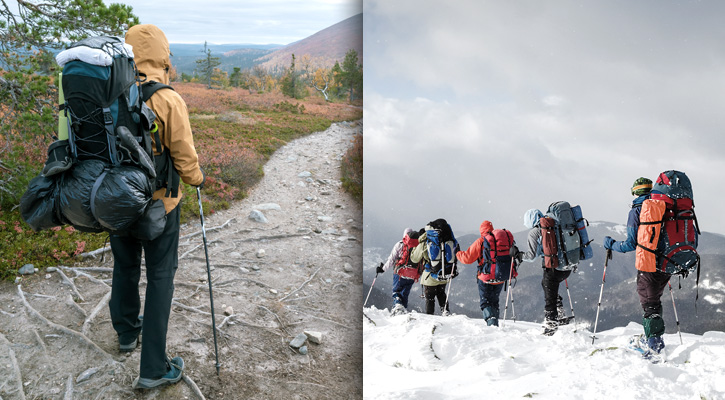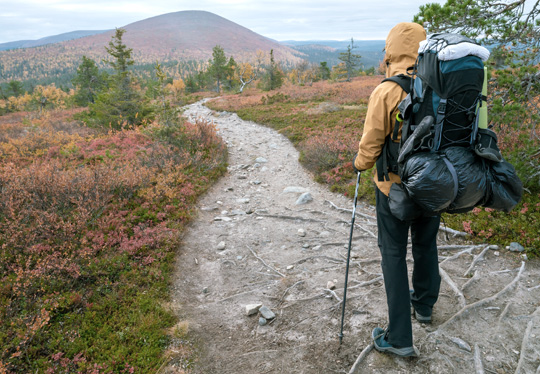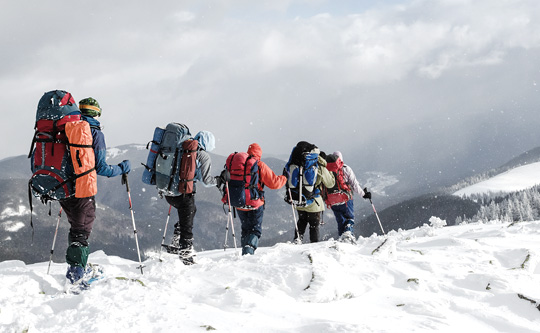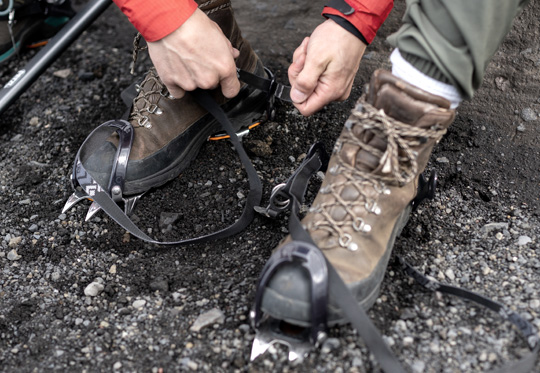
If you’re a fan of hiking and mountaineering, you might think these two activities are very similar. However, there are significant differences between the two.
From equipment to preparation, and even the terrain, hiking and mountaineering have their own unique characteristics.
In this article, we’ll take a closer look at the differences between hiking and mountaineering to help you decide which adventure is right for you.
Let’s begin!
Key Points:
- Hiking and mountaineering have significant differences in terms of equipment, preparation, and terrain.
- Hiking is a recreational walk through nature.
- Mountaineering involves climbing mountains to reach high points, making it more narrowly defined.
- Mountaineering is more challenging, often requiring overnight food and shelter.
- Trekking is another term, referring to a long journey traveled by foot.
- Hiking equipment varies, but a sturdy pair of hiking footwear and water are essential.
- Mountaineering equipment involves warmer clothing, food and camping supplies, protective boots, gear for scaling walls, and trekking poles.
- Mountaineering boots offer more protection and are more expensive.
1. Hiking

According to the dictionary, hiking is described as a recreational walk through nature. However, this definition hardly captures the essence of what hiking truly is.
Both amateur and professional hikers would likely compare it to a form of sport that is similar to running, but less competitive and more focused on experiencing nature than improving one’s physical health.
The physical demands of hiking are distinct from other outdoor activities, as they depend largely on the trail you choose rather than your own abilities. Various trails have different levels of difficulty, and factors such as the length of the route and the weather conditions can significantly impact the experience of the hike.
The most significant aspect of hiking is its accessibility. Short hikes lasting an hour or less can be undertaken without the need for extensive supplies, while longer hikes require more preparation and equipment. Whether as a weekend activity near a public park or as part of a camping trip, a good route is all that’s required to begin hiking.
As a result, hiking encompasses a wide range of activities, from shorter, less challenging hikes to more demanding multi-day hikes on rough terrain. Despite the differences in approach, all of these activities can be classified as hiking, making it a versatile and adaptable activity that can be enjoyed by anyone.
2. Mountaineering

Compared to hiking, mountaineering is a much more specific activity. The dictionary definition of mountaineering involves climbing mountains to reach high points, making it more narrowly defined than hiking.
While mountaineering includes literal mountain climbing, much of it involves hiking, with some areas requiring ropes for rock climbing up vertical mountain walls. However, the ultimate goal of mountaineering is to reach high points on mountains and peaks, which sets it apart from hiking.
Mountaineering expeditions are typically more challenging and time-consuming than hiking trips, often requiring overnight food and shelter due to the length and exclusivity of the paths.
While there is a variety of styles of mountaineering, it is not merely a variation of hiking. It is a complex outdoor activity that requires a range of skills from the world of outdoor walking and travel sports.
Due to its challenges and remote locations, mountaineering is less commonly attempted and enjoyed regularly than hiking.
3. Hiking vs. Trekking vs. Mountaineering: What Are the Differences?
As previously mentioned, hiking and mountaineering are challenging to compare since one is more specific than the other.
Hiking is a broad term that encompasses any style of outdoor walk or journey, while mountaineering involves reaching mountaintops through trails, climbing, and long expeditions.
Although mountaineers do a lot of hiking, hiking is a significantly more general activity.
Trekking is another term that is worth mentioning as it is even more loosely defined. Essentially, trekking refers to a long journey traveled by foot. Not all trekking can be classified as hiking, but virtually any style of hiking can be described as trekking.
The primary differences between these three activities lie in their specificity. Trekking can take place in any environment, from cities to nature, while hiking is specifically a foot journey in nature. Mountaineering involves a lot of hiking but is limited to mountain trails and ranges and necessitates additional skills and resources.
4. What Equipment Do You Need For Hiking?
The equipment required for a hike varies significantly depending on the type of hike. Regardless of the hike, a sturdy pair of hiking shoes or boots is essential, with heavier footwear recommended for longer or more challenging trails.
For multi-day hikes, it is also necessary to bring a sufficient amount of food and water, usually carried in a backpack. Some hikers going on long journeys may choose to bring trekking poles for added support.
While many accessories can be useful, they are not necessarily essential. For instance, hydration bladders from brands such as CamelBak or Osprey are beneficial if you don’t plan on stopping frequently, allowing you to drink water without needing to refill or carry small water bottles.
Ultimately, the most critical items for a hike are a sturdy pair of hiking shoes or boots to provide stability on natural terrain and water to stay hydrated.
Read also: 9 European Backpack Brands for Hiking and Outdoor Activities
5. What Equipment Do You Need For Mountaineering?

Mountaineering involves longer journeys and a more hazardous environment, necessitating carrying more gear than the average hiker.
Regarding clothing, warmer and heavier clothing is typically required to cope with colder climates, necessitating a thick jacket rather than lighter spring or summer outerwear.
Additionally, a significant amount of food, camping supplies, mountaineering boots, and equipment for scaling walls may be necessary, depending on the journey. As mountaineers are likely to encounter snow, trekking poles are also essential to maintain stability on slippery and difficult terrain.
Read next: 10 Italian Hiking Boot Brands: Our Favorites
6. Hiking vs. Mountaineering Boots: What’s the Difference?
To engage in mountaineering, it is essential to have a good mountaineering boot. These products are more specific than hiking boots or shoes worn on simple hiking trails, much like the activity itself.
Hiking boots and shoes come in various forms, ranging from smaller trail runners to thick ankle boots, each providing different support and intended for particular trails and hiking styles.
Mountaineering boots, on the other hand, are more purpose-driven, offering more protection and being more expensive. The best mountaineering boots are typically high-cut on the ankles and reinforced with thick rubber soles on the bottom to maintain traction on slippery surfaces and steep terrain.
Given the increased danger of adventuring on a mountain, weaker or less reliable footwear can be significantly more detrimental in mountaineering than it often is for hiking.
Don’t miss: 9 High-End, Expensive Hiking Brands for Clothing and Footwear
